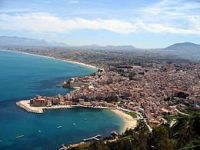Home - In und um
CASTELLAMMARE DEL GOLFO
Castellammare del Golfo, according to the consolidated opinions of historians and geographers, came into being as an ‘emporium’ of the nearby town of Segesta - that is to say, it is the place where the Elimi - an ancient and mysterious population - traded with foreign ships. So the history of the little town on the gulf is identified - at least until 827
a.C., when it became an Arab place - with that of Segesta, whose vicissitudes it shared. Always clashing with the
Greeks of nearby Selinunte - against whom bloody battles were often fought - the important Elimo centre always orbited
around Carthaginian power, which made the ‘emporium’ one of the most important fortified trading stations in the northern basin of Sicily. When Greek power declined in Sicily, the Carthaginians found themselves facing other, more determined enemies: the Romans.
The Punic Wars were the last act of the Carthaginian story and hence of Segesta too but not of the ancient emporium. Indeed, the victors, fully realising its importance, repopulated it, maintaining and boosting its military characteristics.
It was the Arabs that made the place - renamed ‘Al Madarig’, “the steps”, perhaps on account of a rough and very steep street - into a strong-hold, made impregnable by the building of a fortress, and also into an important commercial centre, with the building of the tuna station and the port.
We have little information about the ensuing Norman and Hohenstaufen epoch - going from 1071 to 1280 - but it is probable that there was an improvement in the fortifications of ‘Al Madarig’, which, with the construction of the fortress over the sea, came to be called ‘Castello a mare’; however, it was the Aragonese - who took over the town after the Sicilian Vespers - who gave the powerful fort its final layout. In the Aragonese period (1281-1410), the little town was part of the baronial estate of Federico d’Antiochia, and became an important trading centre linked to corn export. The further development of
Castellammare - which with varying fortune maintained its role as a harbour - is to be ascribed to the period going from the seventeenth to the nineteenth century, when it grew considerably in size and importance.
Nowadays Castellammare del Golfo, thanks to a priceless heritage, that of the extraordinary natural beauty of
its coasts and its immediate hinterland, has rightly become an important mecca for tourists with a lot to offer.
Fonte: sito comune Castellammare del Golfo
a.C., when it became an Arab place - with that of Segesta, whose vicissitudes it shared. Always clashing with the
Greeks of nearby Selinunte - against whom bloody battles were often fought - the important Elimo centre always orbited
around Carthaginian power, which made the ‘emporium’ one of the most important fortified trading stations in the northern basin of Sicily. When Greek power declined in Sicily, the Carthaginians found themselves facing other, more determined enemies: the Romans.
The Punic Wars were the last act of the Carthaginian story and hence of Segesta too but not of the ancient emporium. Indeed, the victors, fully realising its importance, repopulated it, maintaining and boosting its military characteristics.
It was the Arabs that made the place - renamed ‘Al Madarig’, “the steps”, perhaps on account of a rough and very steep street - into a strong-hold, made impregnable by the building of a fortress, and also into an important commercial centre, with the building of the tuna station and the port.
We have little information about the ensuing Norman and Hohenstaufen epoch - going from 1071 to 1280 - but it is probable that there was an improvement in the fortifications of ‘Al Madarig’, which, with the construction of the fortress over the sea, came to be called ‘Castello a mare’; however, it was the Aragonese - who took over the town after the Sicilian Vespers - who gave the powerful fort its final layout. In the Aragonese period (1281-1410), the little town was part of the baronial estate of Federico d’Antiochia, and became an important trading centre linked to corn export. The further development of
Castellammare - which with varying fortune maintained its role as a harbour - is to be ascribed to the period going from the seventeenth to the nineteenth century, when it grew considerably in size and importance.
Nowadays Castellammare del Golfo, thanks to a priceless heritage, that of the extraordinary natural beauty of
its coasts and its immediate hinterland, has rightly become an important mecca for tourists with a lot to offer.
Fonte: sito comune Castellammare del Golfo



